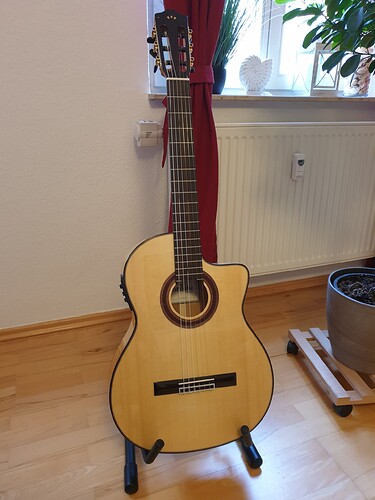Hi all,
about 2 weeks ago I went to Thomann (the closest largest music store from where I live ![]() ) because I wanted to buy a guitar. Until then, I had no clue at all about guitars (and still don’t have) so I didn’t really know what to look for. I only had decided that I wanted an acoustic/classical guitar. Just felt “natural” to me, don’t really know why.
) because I wanted to buy a guitar. Until then, I had no clue at all about guitars (and still don’t have) so I didn’t really know what to look for. I only had decided that I wanted an acoustic/classical guitar. Just felt “natural” to me, don’t really know why.
After the shop assistant had shown me some guitars and had played a bit on the different guitars (because I couldn’t play them myself ![]() ), I bought this one – a Córdoba GK Studio:
), I bought this one – a Córdoba GK Studio:
After I’ve read through some of the discussions here, there are a lot of topics I really don’t know anything about. So there are a lot of questions in my head. What do I need to know about this guitar? And why is it important? So I’ll try to split this up into several sections. And no, I don’t expect anybody to answer all of my questions ![]()
The guitar itself
The guitar is “officially” a Flamenco guitar. The shop assistant said that the sound of Flamenco guitars is a bit different because they are made from different wood. We compared it to a Córdoba Fusion 14 Maple which is a classical guitar from the same brand, but I didn’t really here a big difference.
As a Flamenco guitar it has a tap plate, but I doubt I’ll ever use it ![]() But I don’t mind it either.
But I don’t mind it either.
It has a built-in Fishman pickup system with piezo + microphone, but I’ve not used it so far. The shop assistant said it is quite good. The built-in tuner comes handy and works very well for me.
I’ve learned already that Flamenco guitars have a rather low action height. Although I have no special tools to accurately measure it, this seems to be the case. But I don’t have an idea what that really means and what difference it makes.
Strings
I bought a spare set of strings. It’s a Savarez 500CJ New Cristal / Corum High Tension set. The shop assistant said it’s the same strings that the guitar came with. And she said that I should only use high tension strings on that guitar. But I don’t have an idea why.
What’s the difference between different tensions? My first intuitive idea was that higher tension would make the tone higher. Isn’t that how tuning a guitar works? So how can strings with different tensions still produce the same tone? But I guess I’m just not that good in physics ![]()
When do you need to change a string in general? Obviously when it snaps ![]() Any other reasons? As changing strings on an acoustic guitar looks a bit technically challenging, I hope I don’t have to do it anytime soon
Any other reasons? As changing strings on an acoustic guitar looks a bit technically challenging, I hope I don’t have to do it anytime soon ![]()
Fret markings
Why do all guitars seem to have markings on the 3rd, 5th, 7th, 9th and 12th frets?
The 12th fret is the octave, that was pretty obvious to me. Then I thought “Maybe it helps with scales!?” But when I think about the usual scales (major scale, for example) then marking the 3rd, 5th, 7th and 9th fret doesn’t seem to make much sense!?
Picks
The shop assistant said that you don’t play classical guitars with a pick at all. But she gave me some of their “Harley Benton” (Thomann’s own brand) picks because I insisted. They are 0.46 mm, 0.71 mm, and 0.96 mm.
To be honest, I don’t like the sound of playing with a pick at all. The sound of the pick on the strings is so loud that it is almost louder than the sound of the strings itself. This really annoys me. Perhaps it is so loud because those picks have quite a rough surface. I had imagined picks to be rather smooth!?
And what about the thickness? In one of the introductory videos Justin said that he suggests to use the thinnest pick you can get. But a friend of mine said that she likes to play with a thicker pick, as “stiff” as possible.
Cleaning and maintenance
How should I clean the guitar? And how often is it necessary?
What kind of maintenance does it need? I read about lemon oil. What is it good for? And how often is it used?
To be honest, I’ll probably want to do as little as possible in this area. I want to play the guitar. And not think about doing some maintenance to it all the time ![]()
Anything else?
Any other important topics that come to mind? I am grateful for any tips and guidance!



